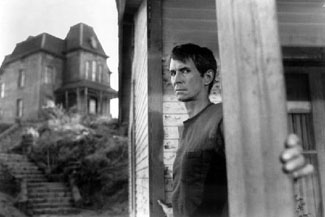Chapter Two: Psycho II
By Brett Beach
May 26, 2011
There is an anecdote about Alfred Hitchcock — perhaps apocryphal although it certainly fits with his cultivated persona of black comic drollery — in which Hitch was on the receiving end of a letter from an irate mother:
“Dear Mr. Hitchcock, ever since seeing your film Psycho, my son has been afraid to take a shower. What should I do?”
“Madam, I suggest you send him out for dry cleaning.”
An auteur, a craftsman, and a consummate showman who knew how to sell himself as a brand to help sell his movies (for only one example, do a web search for the teaser trailer for Psycho), Hitchcock had few equals then or now. Psycho holds a special place among his films, not for being the best, but for its unexpected plot surprises, and three of the most finely crafted sequences of horror/terror the cinema has to offer. Hitchcock and screenwriter Joseph Stefano, working from Robert Bloch’s novel, knew just how to bring unpalatable material to the movie-going public at large. (Compare this with the reception at the time accorded to fellow British director Michael Powell’s chilly chiller Peeping Tom, a film with very similar thematic concerns that opened in the same year as Psycho, was largely derided and blasted, and effectively wrecked Powell’s career.)
It may seem heresy that there have been three sequels, an aborted attempt at a television series spinoff in the late ‘80s (“The Bates Motel” with Bud Cort), and an, ahem, frame-by-frame remake — a few words on that in a second — thus far, but none of them detract from Hitchcock’s achievement. It was in fact Van Sant’s 1998 homage/rip-off/art installation take on Psycho that helped me finally make my own peace with Hollywood’s constant and continual exhumation of everything “old."
As Van Sant’s “prize” for the commercial and Oscar success of Good Will Hunting; as a time capsule of Vince Vaughn’s uber-eclectic film choices in the years post-Swingers (see also: Return to Paradise, The Lost World, Clay Pigeons, The Cell), as an attempt to be wholly “faithful” to source material while exerting your own style and influence — all of these reasons and others give Psycho GVS a curio factor.
But I have always felt that the raison d’être for the entire thing is at the very end. Every time I watch the scene that plays out over the closing credits, which is nothing more than a four minute long unbroken overhead shot of police cars and emergency vehicles pulling away from the swamp where Norman Bates has buried his victims, eventually leaving the frame empty of human activity, I am always seized with the feeling that this time I will see or hear... something. Something hidden in the frame will leap out, or the ambient noise of insect life at dusk will give way to a shattering scream. In its uneasy mood and twilight setting, it is the antithesis of the traveling car sequence that closes Good Will Hunting. “We all go a little mad sometimes,” indeed!
Continued:
1
2
3
|
|
|
|




